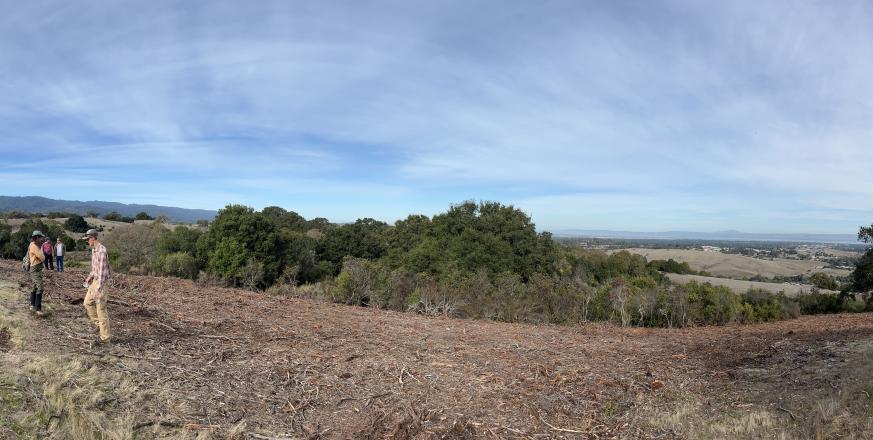Fuel reduction efforts for 2023 have wrapped up at Jasper Ridge Biological Preserve

Fuel reduction efforts for 2023 have wrapped up at Jasper Ridge Biological Preserve, and planning for the next phase of work has already begun which will introduce “good fire” back to the landscape at the preserve.
The first phase of work was completed over the summer, as summarized in this blog post and explains how this work has been part of the 2021 Stanford Wildfire Management Plan. This plan informed how fuel reduction for wildfire mitigation is being conducted across all Stanford University lands. Jasper Ridge added three additional stewardship components to the wildlife mitigation actions: communicating risk, ecological integrity and adaptive management. The work at Jasper Ridge also complimented the annual fuel maintenance work that is completed along all roads, and areas adjacent to SLAC by Jasper Ridge staff. Additionally, SLAC staff annually assess and manage for trees under the SLAC lines that transect the preserve. Overall, 171 acres of land was assessed for wildfire risk, and approximately 140 acres were treated in 2023.
Before and After fuel reduction of oak woodland area along Westridge at Mapache Gate entrance. Hand crews removed understory vegetation, removed select trees for spacing, and cut limbs up to 6-8ft from ground. Some vegetation and downed logs were retained for habitat heterogeneity.
To create the shaded fuel breaks this year, we primarily used hand-crews to cut and chip material along Sand Hill Road and the preserve’s Westridge boundary. However, in some areas hand-crews were able to cut vegetative fuels, but a chipper (which is a large equipment tracked in by a pickup truck), was not able to reach some areas due to steep topography, particularly along chaparral areas of Westridge. In this area, we decided to use another fuel reduction tool—pile burning.
Image of piles created in the chaparral area along the Westridge boundary of Jasper RIdge Biological Preserve. Piles are covered with craft paper to keep vegetation partially dry when material is ignited. Piles are tentatively planned to be burned in early 2024, under wet and safe conditions overseen by a CA Certified Burn Boss and with support from Woodside Fire Protection District and CAL FIRE. Burn days announced to the community prior to burn events once ideal weather conditions are identified in the forecast.
Jasper Ridge is very excited about bringing “good fire” back to the land, which controlled or prescribed burning that can achieve multiple goals of fuel reduction, risk mitigation, ecological renewal, and cultural significance. This plan was initiated by Jasper Ridge staff working with partners across the university, including Land Buildings and Real Estate (LBRE), University Fire Marshal (SUFMO), and fuel reduction consultants, with further support from local Woodside Fire Protection District, as well as CAL FIRE.
Piles were constructed in October 2023 and quickly caught the interest of Stanford researchers. One of the benefits of implementing fuel reduction at Jasper Ridge is that it opens new research, education and stewardship activities to Jasper Ridge, the University and the entire regional community. Researchers have the opportunity to conduct studies under real land management conditions. Additionally, students have the opportunity to engage in research projects while also engaging with land managers, fire agency personnel, and Stanford staff including those in community engagement and government affairs.



